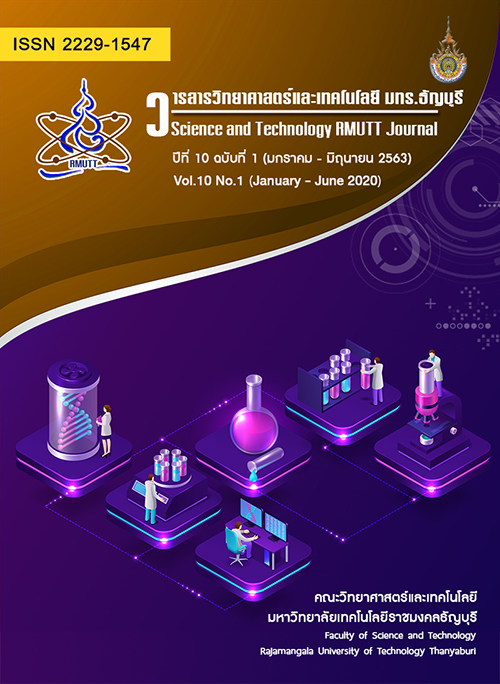Screening of Halophilic Bacteria and Product Characteristic from Salty-Fermented Fish (Pla-ra)
Main Article Content
Abstract
Salty-fermented fish, Pla-ra or Pa-daek is known in Thailand and Lao, respectively, and recognized as seasoning for traditional food. However, production of Pla-ra is often produced in small and medium scale manufacturing for local consumption and also distribution. The aims of this study was to isolate halophilic bacteria and study product characteristic from Pla-ra obtained from different areas (Mukdahan, Nakhon Phanom, Sakon Nakhon of Thailand, and Savannakhet of Laos) and identify character of products. Pla-ra contained pH values at 4.93 - 6.91, 1.32 - 1.98 % acidity, 16.3 - 30.8 Brix of total soluble solid, and 24.86 - 33.58% sodium chloride. There were 40 isolates of halophilic bacteria, and most of them could grow in culture medium containing 20-25% sodium chloride. However, most of strains that showed high proteolytic activity did not show acid production. The sample contained low sodium chloride showed high acidity, low pH, and short fermentation period. Although the result showed that proteolytic and halophilic bacteria play an important role on Pla-ra production, flavor and consumer preference of product are vary from place to place, ingredients, and raw materials. To preserve the diversity of regional food culture, study of bacterial community affecting on flavor and product preference is also need to be conducted to identify quality of Pla-ra production in different areas.
Article Details
References
Dagoon, J. 2000. Agriculture & Fishery Technology III. Rex Bookstore Inc.: 242–243. ISBN 978-971-23-2822-0.
Harrigan, W.F. 1998. Sampling methods for the selection and examination of microbial colo-nies. Pages 89–91 in Laboratory Methods in Food Microbiology. 3rd ed. Academic Press, San Diego, CA.
Hongthongdaeng, P. 1979. A microbiological study on the Thai traditional fermented food product : Pla – ra. (Master of Science Thesis). Kasetsart University.
Hui, Y. H., Goddik, L. M., Hansen, A. S., Josephsen, J., Nip, W. K., Stanfield, P. S. and Toldra, F. 2004. Handbook of Food and Beverage Fermentation Technology. Marcel Dekker. New York, USA.
Jiang, J.J., Zeng, Q.X., Zhu, Z.W. and Zhang, L.Y. 2007. Chemical and sensory changes associated Yu-lu fermentation process – A traditional Chinese fish sauce. Food Chemistry, 104: 1629-1634.
Kim, M.S. & Park, E.J. 2014. Bacterial communities of traditional salted and fermented seafoods from Jeju island of Korea using 16S rRNA gene clone library analysis. Journal of Food Science, 79: M927-M934.
Lee, J.G. & Choe, W.K. 1974. Studies on the variation of microflora during the fermentation of anchovy, Engraulis japonica. Korean Journal of Fisheries and Aquatic Sciences, 7: 105-114.
Marui, J., Boulom, S., Panthavee, W., Momma, M., Kusumoto, K. I., Nakahara, K. and Saito, M. 2015. Culture-independent bacterial community analysis of the salty-fermented fish paste products of Thailand and Laos. Bioscience of Microbiota, Food Health, 34(2): 45–52.
Noda, F., Hayashi, K. and Mizunuma, T. 1980. Antagonism between osmophilic lactic acid bacteria and yeasts in brine fermentation of soy sauce. Applied and Environmental Microbiology, 40: 452-457.
Ok, K.K., Soo, J. L., Kyung, R. C., Dai, J. J., Hye, J. Y. and Dae, Y. K. 2016. Korean traditional fermented fish products: Jeotgal. Journal of Ethnic Foods, 3(2): 107-116., 2016.
Saengkaew, C., Kongkarak, T., Phumeesaeng, A. and Baupai, A. 2017 Amazing of Pla-ra: World Wide Business. https://www.gotoknow.org/posts/628582 ( accessed on 15 June 2018).
Sharma, K. 2007. Manual of Microbiology: Tool and Techniques. Ane Books India. New Del-hi, India.
Suriyanont, A. & Chancharoonpong, C. 2018. Making process and factors associating to properties of fermented fish (Plara) in some parts of upper northeast area of Thai-land. Burapha Science Journal, 23(1): 566-578.
Vichasilp, C. 2005. Screening and utilization of lactic acid bacteria as a starter culture for fermented marine fish (Pla-ra). (Master of Science Thesis). Kasetsart University.


